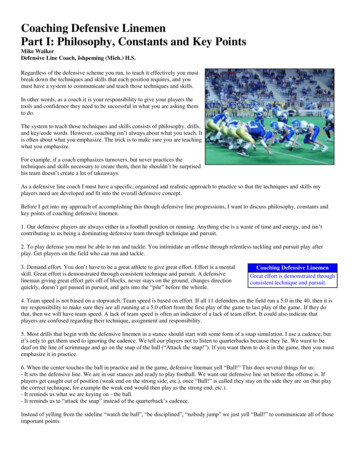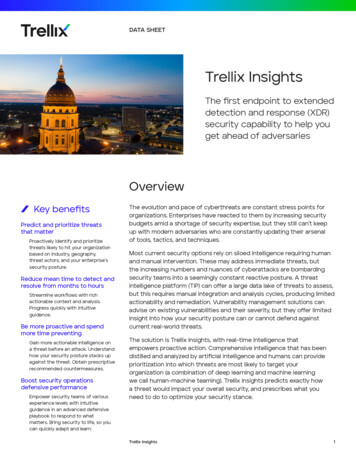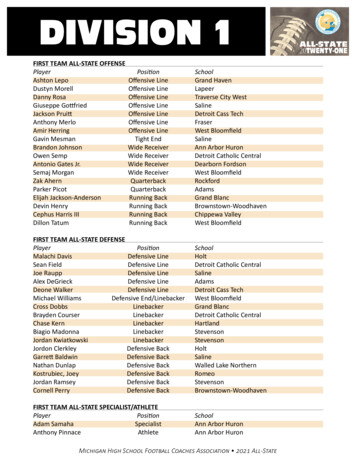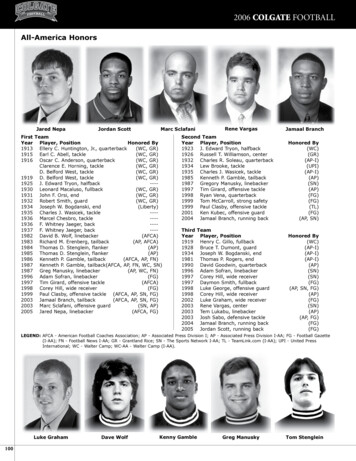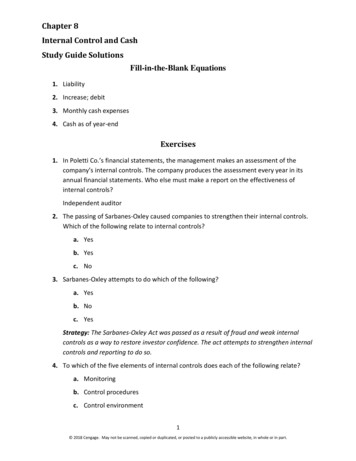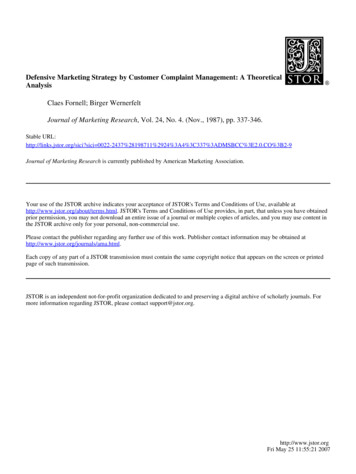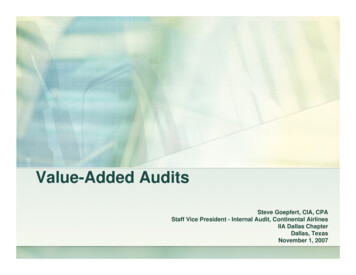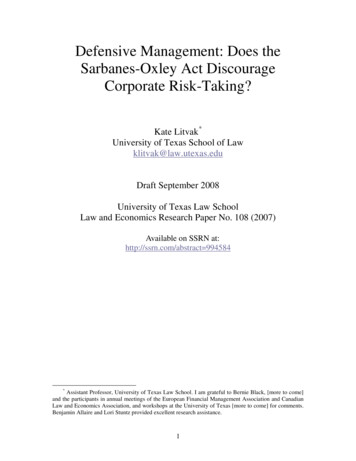
Transcription
Defensive Management: Does theSarbanes-Oxley Act DiscourageCorporate Risk-Taking?Kate Litvak *University of Texas School of Lawklitvak@law.utexas.eduDraft September 2008University of Texas Law SchoolLaw and Economics Research Paper No. 108 (2007)Available on SSRN at:http://ssrn.com/abstract 994584*Assistant Professor, University of Texas Law School. I am grateful to Bernie Black, [more to come]and the participants in annual meetings of the European Financial Management Association and CanadianLaw and Economics Association, and workshops at the University of Texas [more to come] for comments.Benjamin Allaire and Lori Stuntz provided excellent research assistance.1
Defensive Management: Does the Sarbanes-Oxley Act DiscourageCorporate Risk-Taking?AbstractPrior studies find that foreign firms subject to the Sarbanes-Oxley Act (“SOX”) sufferedsignificant declines in market valuation; these declines are too large to be fully explainedby the increased costs of compliance. This paper investigates one possible source oflosses – the charge that SOX discourages corporate risk-taking. I use a triple differencemethodology to estimate the effect of SOX on risk-taking by SOX-exposed foreign firms.I match each foreign cross-listed firm to a similar non-cross-listed firm from the samecountry based on propensity to cross list. I measure the “pair” risk – the differencebetween the risk of a cross-listed firm and the risk of its match (first difference). I thenestimate the after-minus-before SOX change in pair risk (second difference). Finally, Icompare the after-minus-before changes in pair risk for SOX-exposed pairs (where thecross-listed company is listed on level 2 or 3 and is thus subject to SOX) to the changefor SOX-unexposed pairs (where the cross-listed company is listed on level 1 or 4 and isthus not subject to SOX) (third difference). I use three sets of proxies for risk: volatilityof returns, financial leverage, and cash hording. I find that the risk of SOX-exposedforeign firms declined significantly after SOX on all three measures. High-Tobin’s Qfirms suffered larger declines in risk. I also find some evidence of differential compliancewith SOX: size is a negative predictor of changes in risk levels only in low-GDP firms,where only larger, more visible firms are likely expected to comply. Finally, I also findthat firms that were riskier before SOX lost more of their value after SOX, as measuredby changes in firm Tobin’s q. This evidence is consistent with the view that SOX inducedcross-listed firms to take fewer risks, and placed a particular burden on riskier and wellgoverned firms.2
1. IntroductionThe Sarbanes-Oxley Act of 2002 (“SOX”) 1 is commonly cited as the single mostimportant U.S. business legislation since the 1930s. 2 It regulates virtually everyprofession dealing with public corporations – corporate directors and officers, lawyers,accountants, auditors, securities analysts, financial advisors, and so forth. It affectsfinancial market institutions (stock exchanges, credit rating agencies, investment banks);industry organizations (the American Institute of Certified Public Accountants, theFinancial Accounting Standards Board), and government bodies (the Securities andExchange Commission, the Federal Sentencing Commission).Six years after its adoption, SOX remains highly controversial. Businessmenmostly loathe it, and many academics concur. Major figures in the legal academy havelabeled SOX as “quack corporate governance,” 3 a “debacle,” 4 “deeply flawed policiesthat have no empirical support or economic justification,” 5 representing “the point wherethe costs of regulation clearly exceed its benefits,” 6 with its passage through the Congresscalled “Sudden Acute Regulatory Syndrome,” 7 “legislating in haste,” 8 and “a hasty,panicked reaction of an electorate looking for an easy fix to the apparent ‘problem’ that1Pub. L. No. 107-204, 116 Stat. 745 (codified in scattered sections of 11, 15, 18, 28, and 29 U.S.C.).2According to President George W. Bush, SOX is “the most far-reaching reform[] of Americanbusiness practices since the time of Franklin Delano Roosevelt.” See Elisabeth Bumiller, Bush Signs BillAimed at Fraud in corporations, N.Y. TIMES (July 31, 2002). Former SEC Commissioner HarveyGoldschmid called it the “most sweeping reform since the Depression-era securities laws.” Shanon D.Murray, Is SEC Ready for Its Own Sweeping Changes?, N.Y.L.J. (Aug 29, 2002).3Roberta Romano, The Sarbanes-Oxley Act and the Making of Quack Corporate Governance, 114YALE L.J. 1521 (2005).4Henry N. BUTLER & LARRY E. RIBSTEIN, THE SARBANES-OXLEY DEBACLE: WHAT WE’VE LEARNED;HOW TO FIX IT (2006).5Stephen M. Bainbridge, The Creeping Federalization of Corporate Law, REGULATION, Spring 2003,at 26.6William J. Carney, The Costs of Being Public After Sarbanes-Oxley: The Irony of “Going Private,”55 Emory L.J. 141, 141 (2006).7Larry E. Ribstein, Sarbox: The Road to Nirvana, 2004 MICH. ST. L. REV. 279; see also Larry E.Ribstein, Bubble Law, 40 HOUS. L. REV. 77, 89 (2003) ""regulating in a panic").8Stephen M. Bainbridge, Sarbanes-Oxley: Legislating in Haste, Repenting in Leisure (UCLA Schoolof Law, Law-Econ Research Paper No. 06-14), available at: http://ssrn.com/abstract 899593
stock prices go down as well as up.” 9 A report by the "Paulson Committee," an ad hocCommittee on Capital Markets Regulation created by Treasury Secretary Henry Paulsonand staffed by prominent academics, argues that SOX is hurting the competitiveness ofAmerican firms and stock markets. 10Not everyone shares this view. Prominent scholars in both law and finance haveopined that the U.S. remains the leader in adopting value-increasing corporategovernance rules, that SOX did now harm to this status, 11 and that compliance costs arecoming down as companies and accountants gain experience with the new rules. 12Others saw value in SOX from the start, describing SOX as needed “damage control”,13“a step in the right direction,” 14 and welcomed it for “helping strengthen emerging normsof active monitoring by directors and officers.” 15 Some scholars applauded SOX asbenefiting not only “corporations and their shareholders but their constellation ofconstituents as well.” 16The criminal provisions of SOX were expected to provide9Robert W. Hamilton, The Crisis in Corporate Governance: 2002 Style, 40 HOUS. L. REV. 1, 49(2003).10Committee on Capital Markets Regulation, Interim Report (Nov. 30, e Interim ReportREV2.pdf; see also Luigi Zingales, Is theU.S. Capital Market Losing its Competitive Edge?, J. ECON. PERSPECTIVES (forthcoming 2007); MichaelBloomberg and Charles Schumer, “Sustaining New York’s and the U.S.’s Global Financial ServicesLeadership” (January 22, 2007) (Mr.Bloomberg is Mayor of New York City and Mr. Schumer is a memberof the House of Representatives from New York City).11Craig Doidge, Andrew Karolyi, and Rene M. Stulz, Has New York Become Less Competitive inGlobal Markets? Evaluating Foreign Listing Choices over Time (working paper 2007), available on SSRNat http://ssrn.com/abstract 982193; John C. Coffee, Jr., Law and the Market: The Impact of Enforcement(working paper 2007), available on SSRN at http://ssrn.com/abstract 967482. See also Robert A. Prenticeand David B. Spence, Sarbanes-Oxley as Quack Corporate Governance: How Wise is the ReceivedWisdom? (working paper, 2006), available at http://srn.com/abstract 945796.12E.g., Coffee (2007), supra note xxx; John C. Coates, IV, The Goals and Promise of the SarbanesOxley Act, J ECON. PERSPECTIVES, Winter 2007, at 91-116 ("Sarbanes-Oxley should bring net long-termbenefits").13Larry Cata Backer, The Sarbanes-Oxley Act: Federalizing Norms for Officer, Lawyer, andAccountant Behavior 76 ST. JOHN’S L. REV. 897, 951 (2002).14Neil A. Aronson, Preventing Future Enrons: Implementing the Sarbanes-Oxley Act of 2002, 8 STAN.J.L., BUS. & FIN. 127 (2002);15Brett McDonnell, Sarbanes-Oxley, Fiduciary Duties, and the Conduct of Officers and Directors(University of Minnesota Legal Studies Research Paper Series, Research Paper No. 04-13, July 28, 2004),available at http://ssrn.com/abstract 570321.16Lawrence E. Mitchell, The Sarbanes-Oxley Act and the Reinvention of Corporate Governance?, 48VILLANOVA L. REV. 1189, 1189 (2003).
“powerful incentives for targets of criminal fraud investigations to help prosecutors buildcases against other participants in the fraud.” 17Finally, some reactions were of the “much ado about nothing” variety. “[T]he Actreenacts in a new federal guise . . . existing federal regulations, state laws, stock exchangeand securities industry rules, accounting or auditing practices, and corporate governancenorms. These codifications do little more than shine a spotlight on some ‘best practices,’an important function but hardly ‘reform’ of any sort, ‘sweeping’ or otherwise.” 18 “As apractical matter, [SOX’s provisions on obstruction of justice] criminalize very little newconduct and therefore carry very little, if any, additional deterrence benefit,” while“penalty enhancements seem unlikely to deter corporate crime to any greater degree thancurrent provisions.” 19The debate between “pro” and “con” groups continues, fueled by the newestempirical evidence produced (mostly) in business schools. The winner, however, hasfailed to emerge: empirical evidence on the impact of SOX is mixed. Some studies find avariety of negative effects, while others find positive effects, no effects, or mixedeffects. 20Two main problems make it difficult to conduct empirical studies of SOX andinterpret their results. First, the costs and benefits of SOX are hard to quantify. Forexample, on the cost side, both supporters and opponents of SOX agree that the directcosts of new requirements (such as increased audit fees or management time directlydevoted to the preparation of compliance documents) are only a portion of overallcompliance costs. The rest -- and a major focus for critics -- are hard-to-measure costs ofwhat one can call “defensive management” – excessive caution and bureaucratismdesigned to avert SOX-related litigation or investigation. Examples include redundantmeetings; unnecessary requests for outside opinions from bankers, consultants, and17Kathleen F. Brickey, From Enron to WorldCom and Beyond: Life and Crime After Sarbanes-Oxley,81 Wash. U. L. Q. 357, 360 (2003).18Lawrence A. Cunningham, The Sarbanes-Oxley Yawn: Heavy Rhetoric, Light Reform (And It JustMight Work), 35 CONN. L. REV. 915 (2003).19Michael A. Perino, Enron's Legislative Aftermath: Some Reflections on the Deterrence Aspects ofthe Sarbanes-Oxley Act of 2002, 76 ST. JOHN'S L. REV. 671, XXX (2002).20Part I, infra, discusses the rapidly growing empirical literature on SOX.
lawyers; excessive vetting of communications through inside counsel; multiplication ofinternal approvals, and beefing up internal procedures beyond the point that would becost-justified. Other forms of defensive management could include restructuring abusiness in a way that would make it look more familiar and thus less suspicious toauditors who must vouch for the adequacy of the firm's internal controls; avoiding novelmanagement techniques and compensation arrangements; retaining inefficient businesspractices because new practices call for new internal controls, which must be documentedand then vetted by counsel and accountants; 21 moving away from flexible, decentralized,and often ad hoc decisionmaking toward slower, more bureaucratized procedures; anddiscouragement of entrepreneurialism and initiative. 22 While many commentators agreethat SOX triggered some degree of defensive management, they disagree on the severityof the problem. 23At the same time, SOX’s potential benefits are hard to quantify as well. SOX maycreate value not only by directly reducing fraud, but also by allowing corporate insidersto credibly promise not to engage in fraud in the future, which may reduce the cost ofcapital today. Indeed, increased investor confidence is often listed as one of the majorgoals of SOX by politicians, 24 regulators, 25 academics, 26 business leaders, 27 and othercommentators. 28 And yet, measuring investor confidence is notoriously hard.21See Butler & Ribstein, supra note XXX, at 44.22See, e.g., Peter Wallison, If the Financial Pre-Eminence of the U.S. Is Eroding, as Several RecentReports Contend, what's Really to Blame?, WALL ST. J., March 20, 2007.23See, e.g., Joel Seligman, No One Can Serve Two Masters: Corporate and Securities Law AfterEnron, 80 WASH. U.L.Q. 449, fn 173-177 and accompanying text (2002) (bureaucratization costs of SOXare modest compared to benefits), McDonnell, supra n.XXX (same); Michael A. Pernio, American ReformAbroad: Sarbanes-Oxley and the Foreign Private Issuer (SOX compliance costs are modest for foreigncross-listed companies); Carney, supra note XXX (costs of defensive management too high to justifybenefits); Larry E. Ribstein, Sarbanes-Oxley after Three Years (working paper, 2005). Available athttp://ssrn.com/abstract 746884. (same); Donald C. Langevoort, Internal Controls After Sarbanes-Oxley:Revisiting Corporate Law’s Duty of Care as Responsibility for Systems, 31 J. CORP. L. 949 (2006) (closecall).24See See Mike Allen, Bush Signs Corporate Reforms into Law: President Says Era of “False Profits”is Over, WASH. POST, July 31, 2002.25See, e.g., Willian H. Donaldson, Testimony concerning the Impact of the Sarbanes-Oxley Act Beforethe House Committee on Financial Services (April 21, 2005) (“The goals of the Sarbanes-Oxley Act arefar-reaching, and aim to restore investor confidence in and assure the integrity of our markets.”), availableat 26See, e.g., Stephen Kwaku Asare, Lawrence A. Cunningham & Arnold Wright, The Sarbanes-OxleyAct: Legal implications and Research Opportunities (Boston College Law School Legal Studies Research
One common solution to estimating the hard-to-quantify costs and benefits of newlegislation is to measure market reaction. If causation can be established (a big “if” that Iaddress below), a positive stock price movement when legislative events occur signals anoverall positive investor reaction. However, this approach has a variety of weaknesses.First, it measures the overall investor reaction, but does not tell us what exactly investorsliked or disliked. Second, market studies indicate investor reaction to new information,not investor reaction to legislation itself. At the extreme, even if investors view newlegislation negatively, markets may still move positively on legislative news if investorsexpected the bill to be worse than it turned out at to be. Finally, if investors misjudged thelong-term effects of SOX, their short-term reactions may be an unreliable guide to itsactual effects.A bigger problem for empirical studies of SOX is that we cannot reliably establishcausation. There is no control group: SOX applies to all US public companies. Thus,even if we can quantify a post-SOX change in the behavior of U.S. firms, we cannotshow a causal relationship because we cannot separate the effect of SOX from the effectof other contemporaneous events. Suppose, for example, that U.S. firms reduced theirrisk levels after SOX (whether they did so is not yet known). We couldn't be surewhether SOX was the cause.This paper makes two principal contributions to our understanding of the effectsof SOX. First, it provides evidence in the form that is most useful to policy makers – onspecific effects of SOX (rather than overall market reactions).Second, this paperSeries, Research Paper 122, 2007), available at http://ssrn.com/abstract 947356 (“Congress passed theSarbanes-Oxley Act to restore investor confidence.”); William W. Bratton, Enron, Sarbanes-Oxley andAccounting: Rules Versus Principles Versus Rents, 48 VILL. L. REV. 1023, 1023 (2003) (describing SOX as“intended to address the scandals and restore confidence in the securities markets.”); Zabihollah Rezaee &Pankaj K. Jain, The Sarbanes-Oxley Act of 2002 and Security Market Behavior: Early Evidence (workingpaper 2005), available at http://ssrn.com/abstract 498083 (“To restore investor confidence and reinforcecorporate accountability Congress passed the Sarbanes-Oxley Act.”), at p. 1.27See, e.g., John J. Castellani, Testimony before the Senate Committee on Banking, Housing andUrban Affairs (October 23, 2003) (commenting, in a testimony called “Implementation of the SarbanesOxley Act and Restoring Investor Confidence,” that “[a]ll of us – Congress, the SEC, the securities marketsand the corporate community – have worked hard to restore investor confidence over the past two years,and we are proud of those efforts.”). Available at http://banking.senate.gov/ files/castlani.pdf.28See Paul Lowengrub, The Impact Of Sarbanes Oxley On Companies, Investors, & FinancialMarkets, SARBANES-OXLEY COMPLIANCE J. (Dec 6, 2005), available at http://www.sox.com/feature/detail.cfm?articleID 1385 (“The primary goal of SOX was to help investor confidence inthe public marketplace”)
examines the worldwide impact of SOX. Prior research on the effect of SOX on non-UScompanies has concentrated on market reactions and decisions to enter/exit the U.S.market. This paper, in contrast, provides evidence on adaptive steps that companiesaround the world took in response to SOX.The primary innovation of this paper is in its research design, which allows usestablish causation. As mentioned before, studies of SOX in US firms face severecausation challenges because we do not have a baseline against which we can measurefirms’ adoptive response. I overcome this challenge by using a natural experiment thatisolates the effects of SOX. SOX applies not only to all U.S. public companies, but alsoto foreign firms whose stocks are traded on major U.S. exchanges – that is, firms crosslisted on levels 2 or 3 (“level-23” firms). SOX does not apply to foreign firms whosestocks are traded in the U.S. in the over-the-counter market or the "Portal" privateplacement market with shares available only to large institutions. These firms are said tobe cross-listed on levels 1 or 4 (“level-14” firms). SOX and U.S. regulation also do notapply to foreign firms whose securities are not traded in the U.S. Thus, while the effectsof SOX cannot be cleanly tested for U.S. firms, a more reliable test is available forforeign firms subject to SOX. For cross-listed firms, we have a “treatment group” (level23 firms) -- to which the SOX "treatment" was applied. We also have two “controlgroups” to which this treatment was not applied --level-14 firms and non-cross-listedfirms).I match each foreign cross-listed firm to a non-cross-listed firm from the samecountry based on a measure of propensity to cross-list. I estimate the propensity to crosslist based on company-level characteristics, generally estimated at year-end of 2001, justbefore SOX was adopted: industry, market capitalization, growth rate, return on assets,leverage, and volatility of returns. I then compute, for a variety of measures of risk, the“pair risk difference” – the difference between the risk of a cross-listed firm and the riskof its non-cross-listed match. This is the first difference in my overall "triple differences"approach. I then estimate the after-SOX (mean of 2003-2005) minus before-SOX (yearend 2001) changes in the pair risk difference. This is the second difference. Othercountry and firm-level factors that affect firms' propensity to take risks, and the changesin this propensity over time, should be similar for a level-23 firm and its match. Thus,
the second difference provides a measure of the effect of SOX on risk-taking, net ofchanges due to these other factors.Finally, I ask whether pair risk differences change differently for level-23 pairsthan for level-14 pairs. This third difference controls for the possibility that the risktaking behavior of level-23 firms changes, relative to their matches, for reasons thatreflect the general exposure of level-23 firms to U.S. securities markets, rather than theirexposure to SOX, because the level-14 firms are exposed to U.S. markets but not to SOX.If level-23 firms change their risk levels relative to their matches, while level-14 firms donot, this is evidence that exposure to SOX is causing – not just correlating with – thechanges in risk.I use three principal sets of proxies for risk: (1) volatility of share returns, whichis a standard measure of the riskiness of shares, and thus of the riskiness of theunderlying business (measured separately as unsystematic risk and total risk); (2)financial leverage (measured separately as total debt over book value of assets and totaldebt net of cash reserves over book value of assets; higher financial leverage implieshigher risk), and (3) cash hording (defined separately as cash over assets and cash overequity). I find evidence, across all measures, that the pair difference in risk declinedsignificantly after SOX for level-23 pairs and did not decline for level-14 pairs. .I also investigate which firm-level and country-level factors predict crosssectional differences in the changes in risk. Higher Tobin’s Q firms experienced strongerreductions in risk.I also find a complicated relationship between firm size, changes in risk levels,and the quality of the firm’s domestic legal and institutional environment. Larger firmsexperienced stronger declines in risk levels, but only if they are located in low-GDPcountries. In high-GDP countries, firm size does not predict changes in firms’ risk levels.This supports the hypothesis of the differential compliance across countries. In countrieswith high-quality legal and institutional environments (as proxied by high GDP), all firmsare expected to comply with SOX; thus, firm size is not likely to affect changes in risklevels. In contrast, in countries with low-quality legal and institutional environment,compliance is often expected only from larger, more visible, and more reputable firms.
This finding is also consistent with prior findings on the relationship between firm size,domestic institutional environment, and post-SOX changes in Tobin’s Q. 29These results are robust to a variety of alternative specifications, including (1)studying firm-level instead of pair-level changes in risk measures; (2) varying thedefinition of the “before” and “after” SOX periods; (3) using firm fixed and firm randomeffects for panel regressions, and country fixed and country random effects for non-panelregressions; (4) using different control variables.This evidence is consistent with the critics' view that SOX negatively affectedcorporate risk-taking, and may have particularly affected firms that were already wellgoverned before SOX.It is also consistent with prior research finding significantdeclines in market valuations of SOX-exposed foreign firms; the magnitude of thedeclines cannot be fully explained by increased costs of compliance. 30 The analysis inthis paper offers a possible explanation for why investors may have reacted negatively toSOX.Finally, some caveats and limitations. First, to create a clean experiment, I studyonly cross-listed companies. It is possible that U.S. firms reacted to SOX differently.However, the logic behind why SOX might have induced managers of cross-listed firmsto take less risk should apply to U.S. firms as well. Moreover, preliminary evidence froma contemporaneous study of U.S. firms indicates that they too may have reduced risklevels after SOX. 31 Second, I find that SOX is associated with significant reduction ofcorporate risk, but I cannot tell whether such reduction is good or bad. It is possible thatfirms were too risky before SOX and have now brought their risk to the right level.Maybe "defensive management," like defensive driving, has a good side. Third, I studyonly risk-taking. It is possible other features of SOX had beneficial effects on firm29See See Kate Litvak, The Effect of the Sarbanes-Oxley Act on Non-US Companies Cross-Listed inthe US, 13 J. CORP. FIN. 195 (2007a) [hereinafter, Litvak, SOX Event Study].30See Kate Litvak, The Effect of the Sarbanes-Oxley Act on Non-US Companies Cross-Listed in theUS, 13 J. CORP. FIN. 195 (2007a) [hereinafter, Litvak, SOX Event Study]. See also Geoffrey P Smith, ALook at the Impact of Sarbanes–Oxley on Cross-Listed Firms (working paper 2007). Available athttp://ssrn.com/abstract 931051; Xi Li, The Sarbanes-Oxley Act and Cross Listed Foreign Private Issuers(working paper, 2007). Available at http://ssrn.com/abstract 952433.31Leonce Bargeron, Kenneth Lehn & Chad Zutter, Sarbanes-Oxley and Corporate lwk01.bm.ust.hk/acct/acsymp/Discussed Papers Thomas ing.pdf
performance. Additional tailored, specific studies of changes in corporate behavior areneeded to adequately address this possibility.2. Related ResearchA number of recent empirical studies papers examine the consequences of theSarbanes-Oxley Act, measured by a variety of indicators, for both U.S. and foreign firms.2.1. Studies of U.S. FirmsThe results from studies of U.S. firms are mixed. On the negative side, the costsof compliance are significant. Average audit fees and premia charged by the Big Fouraudit firms increased significantly, especially for bigger and riskier clients. 32 Somecompanies, particularly smaller ones, responded to high auditor fees by dismissing topauditors and hiring cheaper ones. 33 Internal auditing costs increased. 34 Board of directorscosts rose, especially for small firms.35 It is unclear whether these extra costs improvedthe informativeness of accounting earnings: Cohen, Dey, and Lys find no effect, whileBédard finds a positive effect. 36 SOX has not altered firms' propensity to manipulateearnings through changes in their effective tax rates. 37On the positive side, measures of share liquidity, such as bid-asked spreads anddepth of the available supply of shares, which worsened during the pre-SOX financial32See Sharad Asthana, Steven Balsam & Sungsoo Kim, The Effect of Enron, Andersen, and SarbanesOxley on the Market for Audit Services (working paper, 2004), available at: http://ssrn.com/abstract 560963.33See Michael L. Ettredge, Chan Li &Susan Scholz, Audit Fees and Auditor Dismissals in theSarbanes-Oxley Era (working paper, 2007). Available at: http://ssrn.com/abstract 92948634Susan W. Eldridge & Burch T. Kealey, SOX Costs: Auditor Attestation under Section 404 (workingpaper, 2005). Available at: http://ssrn.com/abstract 74328535James S. Linck, Jeffry M. Netter & Tina Yang, The Effects and Unintended Consequences of theSarbanes-Oxley Act, and its Era, on the Supply and Demand for Directors (working paper, 2007).Available at: http://ssrn.com/abstract 902665.36Cohen, Dey & Lys (2005), supra note xx; Jean Bédard, Sarbanes Oxley Internal ControlRequirements and Earnings Quality (working paper, 2006). Available at http://ssrn.com/abstract 92627137Kirsten A. Cook, George Ryan Huston & Thomas C. Omer, Earnings Management ThroughEffective Tax Rates: The Effects of Tax Planning Investment and the Sarbanes-Oxley Act of 2002 (workingpaper, 2006). Available at: http://ssrn.com/abstract 897749
scandals, improved after SOX, particularly for large firms. 38Both firms and theirauditors identified more internal control weaknesses than during the pre-SOX period.39After SOX, firms’ propensity to manage earnings to meet or beat analyst expectations hasdeclined. 40 Insiders are less likely to trade in the period before their firm restates itsfinancial results. 41Findings on SOX’s effect on executive compensation are mixed. On the negativeside, the ratio of incentive compensation to salary declined significantly. 42 On thepositive side, the faster reporting of option grants required by SOX appears to havereduced managerial timing of option grants. 43Findings on the market reaction of US firms are also mixed. In a much-citedpaper, Zhang 44 finds a significant decline in US share prices during the events leading tothe adoption of SOX. Others, using different methodologies and different controlsamples, find that share prices increased. 45 One study finds that firms which had to makelarger changes to comply with SOX reacted more positively than other firms, while asecond reports that larger, older, and faster-growing firms reacted to SOX-related38See Pankaj K. Jain, Jang-Chul Kim & Zabihollah Rezaee, Trends and Determinants of MarketLiquidity in the Pre- and Post-Sarbanes-Oxley Act Periods (working paper, 2006). Available athttp://ssrn.com/abstract 488142.39Yan Zhang, Jian Zhou & Nan Zhou, Audit Committee Quality, Auditor Independence, and InternalControl Weaknesses (working paper, 2006). Available at http://ssrn.com/abstract 92573240See Eli Bartov & Daniel A. Cohen, Mechanisms to Meet/Beat Analyst Earnings Expectations in thePre- and Post-Sarbanes-Oxley Eras (working paper, 2006). Available at http://ssrn.com/abstract 954857.41Oliver Zhen Li & Yuan Zhang, Financial Restatement Announcements and Insider Trading(working paper, 2006). Available at http://ssrn.com/abstract 929539.42Cohen, Dey & Lys (2005), supra note xx.43See M.P. Narayanan & Hasan Nejat Seyhun, Effect of Sarbanes-Oxley Act on the Influencing ofExecutive Compensation, (working paper, 2005), available at http://ssrn.com/abstract 852964; Lucian AryeBebchuk, Yaniv Grinstein, and Urs C. Peyer, Lucky Directors (working paper, 2006). Available athttp://ssrn.com/abstract 952239.44Ivy Zhang, Economic Consequences of the Sarbanes-Oxley Act of 2002, J. ACCOUNTING & ECON.,(forthcoming, 2008). Available at http://ssrn.com/abstract 96196445See Haidan Li, Morton P.K. Pincus, and Sonja O. Rego, Market Reaction to Events Surrounding theSarbanes-Oxley Act of 2002 and Earnings Management (working paper, 2006). Available athttp://ssrn.com/abstract 475163; Rezaee and Jain, 200
3 a "debacle,"4 "deeply flawed policies that have no empirical support or economic justification,"5 representing "the point where the costs of regulation clearly exceed its benefits,"6 with its passage through the Congress called "Sudden Acute Regulatory Syndrome,"7 "legislating in haste,"8 1 Pub. L. No. 107-204, 116 Stat. 745 (codified in scattered sections of 11, 15 .


